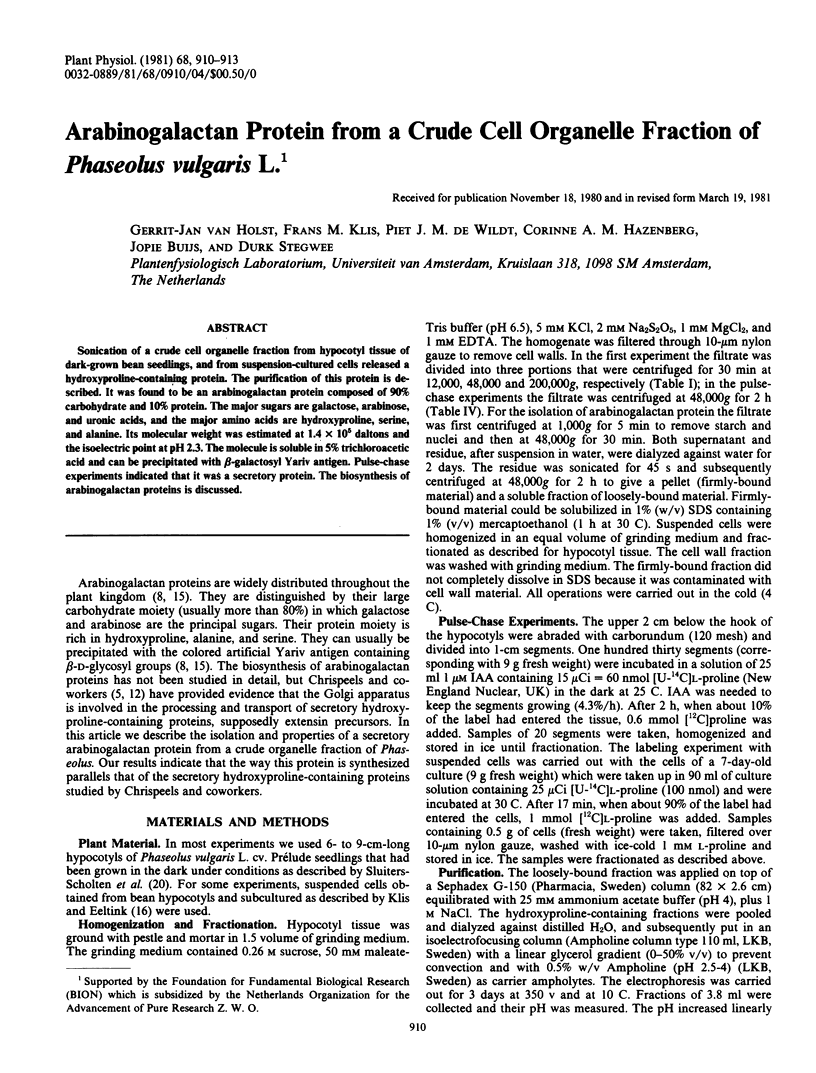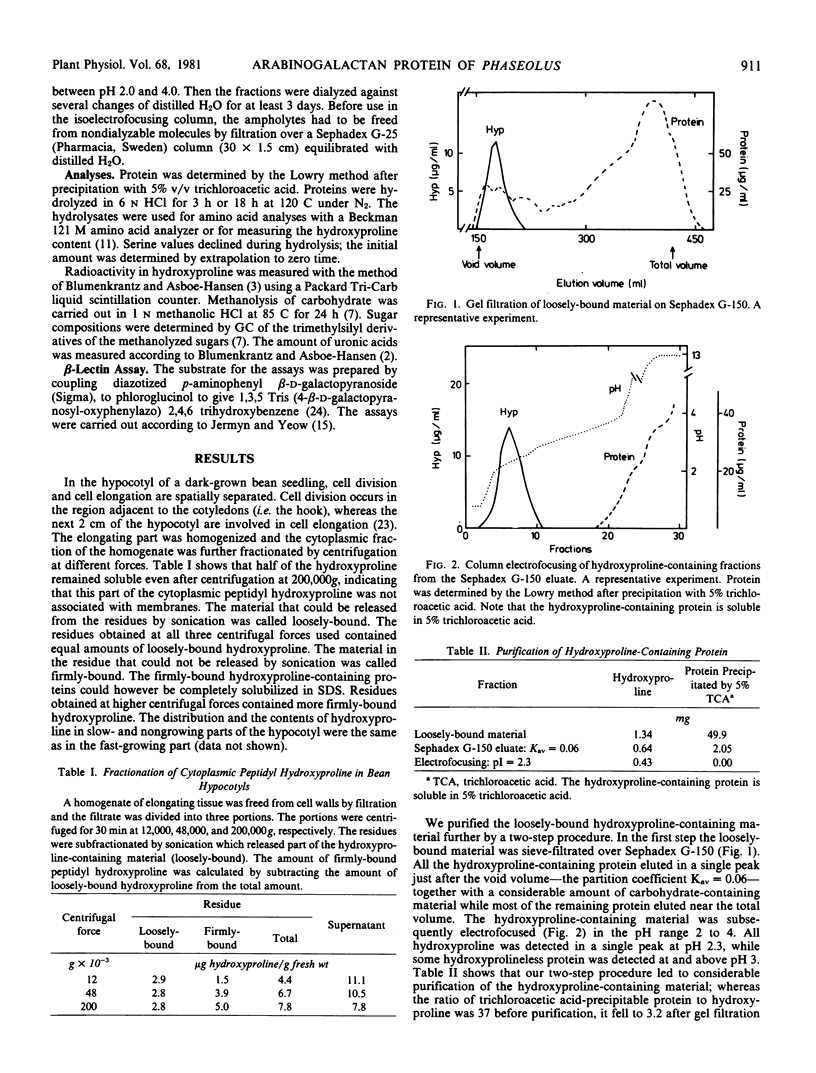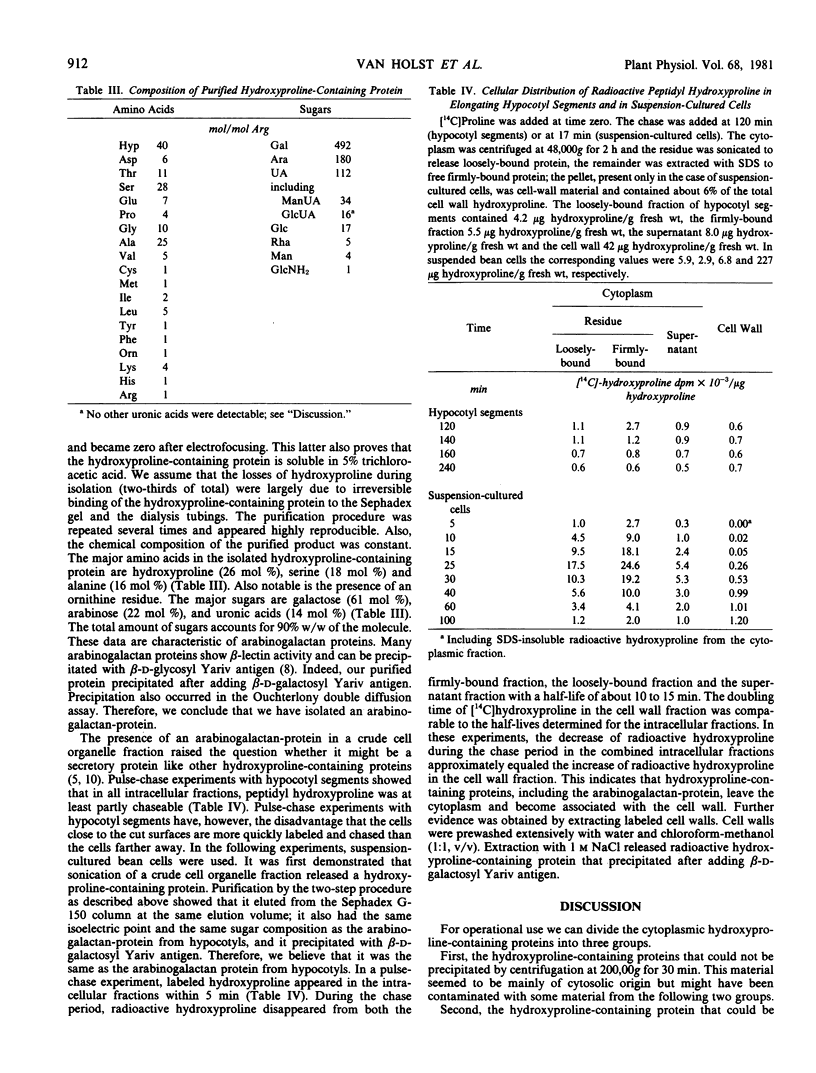Abstract
Sonication of a crude cell organelle fraction from hypocotyl tissue of dark-grown bean seedlings, and from suspension-cultured cells released a hydroxyproline-containing protein. The purification of this protein is described. It was found to be an arabinogalactan protein composed of 90% carbohydrate and 10% protein. The major sugars are galactose, arabinose, and uronic acids, and the major amino acids are hydroxyproline, serine, and alanine. Its molecular weight was estimated at 1.4 × 105 daltons and the isoelectric point at pH 2.3. The molecule is soluble in 5% trichloroacetic acid and can be precipitated with β-galactosyl Yariv antigen. Pulse-chase experiments indicated that it was a secretory protein. The biosynthesis of arabinogalactan proteins is discussed.
Full text
PDF



Selected References
These references are in PubMed. This may not be the complete list of references from this article.
- Allen A. K., Neuberger A. The purification and properties of the lectin from potato tubers, a hydroxyproline-containing glycoprotein. Biochem J. 1973 Oct;135(2):307–314. doi: 10.1042/bj1350307. [DOI] [PMC free article] [PubMed] [Google Scholar]
- Blumenkrantz N., Asboe-Hansen G. New method for quantitative determination of uronic acids. Anal Biochem. 1973 Aug;54(2):484–489. doi: 10.1016/0003-2697(73)90377-1. [DOI] [PubMed] [Google Scholar]
- Blumenkrantz N., Asboe-hansen G. Simple procedures for determination of [14C] hydroxyproline. Anal Biochem. 1975 Jun;66(2):330–339. doi: 10.1016/0003-2697(75)90601-6. [DOI] [PubMed] [Google Scholar]
- Chrispeels M. J. Synthesis and secretion of hydroxyproline containing macromolecules in carrots. I. Kinetic analysis. Plant Physiol. 1969 Aug;44(8):1187–1193. doi: 10.1104/pp.44.8.1187. [DOI] [PMC free article] [PubMed] [Google Scholar]
- Clamp J. R. A gas-liquid chromatographic approach to the analysis of carbohydrates. Biochem Soc Trans. 1977;5(6):1693–1695. doi: 10.1042/bst0051693. [DOI] [PubMed] [Google Scholar]
- Clarke A. E., Knox R. B., Jermyn M. A. Localization of lectins in legume cotyledons. J Cell Sci. 1975 Oct;19(1):157–167. doi: 10.1242/jcs.19.1.157. [DOI] [PubMed] [Google Scholar]
- Dashek W. V. Synthesis and Transport of Hydroxyproline-rich Components in Suspension Cultures of Sycamore-Maple Cells. Plant Physiol. 1970 Dec;46(6):831–838. doi: 10.1104/pp.46.6.831. [DOI] [PMC free article] [PubMed] [Google Scholar]
- Drózdz M., Kucharz E., Szyja J. A colorimetric micromethod for determination of hydroxyproline in blood serum. Z Med Labortech. 1976 Aug 4;17(4):163–171. [PubMed] [Google Scholar]
- Gardiner M., Chrispeels M. J. Involvement of the Golgi Apparatus in the Synthesis and Secretion of Hydroxyproline-rich Cell Wall Glycoproteins. Plant Physiol. 1975 Mar;55(3):536–541. doi: 10.1104/pp.55.3.536. [DOI] [PMC free article] [PubMed] [Google Scholar]
- Pope D. G. Relationships between Hydroxyproline-containing Proteins Secreted into the Cell Wall and Medium by Suspension-cultured Acer pseudoplatanus Cells. Plant Physiol. 1977 May;59(5):894–900. doi: 10.1104/pp.59.5.894. [DOI] [PMC free article] [PubMed] [Google Scholar]
- Stuart D. A., Varner J. E. Purification and Characterization of a Salt-extractable Hydroxyproline-rich Glycoprotein from Aerated Carrot Discs. Plant Physiol. 1980 Nov;66(5):787–792. doi: 10.1104/pp.66.5.787. [DOI] [PMC free article] [PubMed] [Google Scholar]
- YARIV J., RAPPORT M. M., GRAF L. The interaction of glycosides and saccharides with antibody to the corresponding phenylazo glycosides. Biochem J. 1962 Nov;85:383–388. doi: 10.1042/bj0850383. [DOI] [PMC free article] [PubMed] [Google Scholar]


